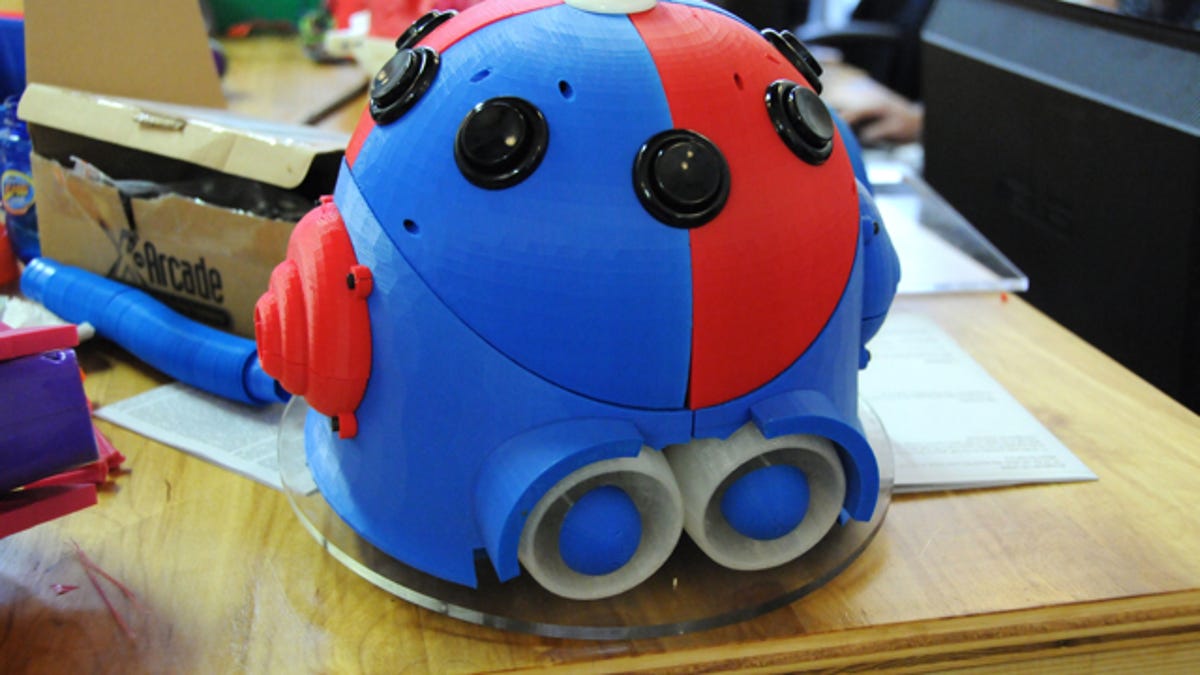MakerBot's robot petting zoo ready to storm Maker Faire
Right now, in an industrial Brooklyn neighborhood, a new breed of robots is coming to life. It's just part of MakerBot's plan to bring 3D printing to life for everyone.

BROOKLYN, N.Y.--Given that Maker Faire is being held next month at a Northern California fairgrounds, it's appropriate that one of the attractions will be a petting zoo.
But this will be unlike any you've seen before. There won't be "animals" on display, and there won't be any fur.
Welcome to the Robot Petting Zoo.
The brainchild of the geeks at MakerBot Industries, the zoo will feature a collection of 3D printed robots, each of which will do something unique. Take "Button bot," for example, a happy-looking android with a head full of, yes, buttons. Push them, and bizarre things will happen. But with no labels, visitors will have to figure out what's happening on their own. It'll be a voyage of discovery, robot style.
It seems entirely appropriate that MakerBot is behind this effort. The company is a leader in developing -- and selling -- 3D printers for the masses. Its most recent offering, the Replicator, is its simplest and most accessible model yet.
But MakerBot doesn't just sell the machines; it uses them, too. And so during a visit to the startup's Brooklyn offices this week, there was no shortage of Replicators churning out small, 3D printed objects and parts, some of which were being used to assemble the various members of the robot petting zoo.
Founded by Bre Pettis, Adam Meyer, and Zach Smith in 2009, MakerBot got its start by selling a rudimentary personal-size 3D printer called the Cupcake. But now, it has moved up in the world, and the Replicator has gotten more than its share of accolades since being released in January. Indeed, the $1,750 machine was awarded a CNET Best of Show award at CES, as well as many other honors.
And why not? As Pettis put it this week, the Replicator is capable of turning out 3D printed objects that are "on par with $20,000 to $60,000 printers. Except we're way more fun."
Software play
In large part, the Replicator is a software play. As Pettis explained, the machine offers buyers not just the ability to produce an infinite variety of items up to the size of a loaf of bread, but improving quality over time. That's because, he said, updates to the machine's software will augment and optimize the printer's capabilities.
Right now, MakerBot is on a roll, and each week seems to bring a new group of freshly-hired employees, many of whom are engineers, and others who work in production and other non-technical positions. Currently, Pettis said, the company churns out between 30 and 40 Replicators a day behind the doors of its "Botcave," but that's a number that may soon seem quaint given that production is about to double.
According to Pettis, one of the most important innovations that went into the Replicator was a decision to change the way the machine actually prints objects. Instead of keeping the print heads -- known as the extruders -- stationary and moving the printed object around, as was the case on the previous MakerBot model, the Replicator keeps the objects still and moves the extruders around.
Another big step forward in making the Replicator mass audience-friendly is the vast difference in how much time it takes a buyer to get the machine up and running. With the Cupcake, Pettis said, it would usually take someone a number of hours to go from taking their new 3D printer kit out of the box to printing their first item. But now, that number has been slashed to 15 minutes, he said.
And that means MakerBot can reach a whole new customer base. "Before, it was programmers and hackers," Pettis said, "and now it's mostly moms and dads.... It's not that we've lost programmers and hackers. It's just that we've added a whole new kind of consumer who want to use it instead of" make it.
Chess sets
While MakerBot is one of the most visible players in the 3D printing space, it is hardly the only one. Indeed, it's not the only company with a high-profile, mainstream, low-cost machine. Recently, 3D Systems released its Cube, a $1,500 device that's tied to its Cubify ecosystem of 3D printing services.
And a wide variety of companies are developing much higher-end machines capable of turning out industrial-quality items. These days, 3D printing is becoming a favorite production method in a wide variety of fields, from Hollywood to space exploration to museums, and many others.
The beauty of 3D printing, Pettis said, is that it's not necessary to worry about whether there's a large customer base waiting to buy your newly designed part or item. "When you have a MakerBot, only you will have to want it," Pettis said, "instead of thousands or millions" of people.
The result is that enthusiasts are now using 3D printers -- either their own or those belonging to companies that take care of printing -- for any number of things. Pettis said one of his favorite implementations is the Chess Set Challenge on Thingiverse, that has resulted in the creation of more than 280 different kinds of chess sets. The best one? One whose pieces all fit together like a Transformer to make a robot.

